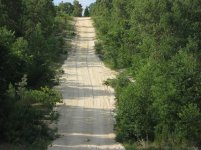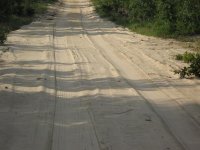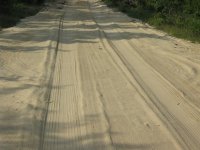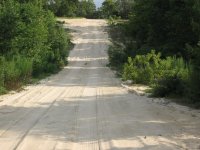Tread70
New member
I could use a little help with my driveway/private road.
I have purchased a 5 ac. flag lot and own the road to which 2 neighbors have an easement. The road is what I can only describe as a beach. My road consists of the same type of sand like you would find on a beach. The road works great for a few days after it rains, but turns to fluff afterward.
My father may possibly be able to get a hold of some Sakrete from his previous employer. I found a .pdf file online that gives an equation to show how much portland cement to add to sand for strengthening my road. I know its not portland but if I add enough I would think it would hold up better than whats there. The bags hold 3000 lbs of Sakrete, a piece.
1. Has anyone ever used Sakrete or cement to ad structure to a very sandy road/drive or make a patio using this concept.
2. How do you think it would hold up under normal auto/pickup traffic?
3. How/What would be the best way to mix the mixture into the sand at say a 5-6" depth?
4. The potential bags my father would be able to get are in 3000 lbs. bags, what would be the easiest way to move /spread the concrete mix onto the road?
5. How would I be able to tamp/compact around 1000 ft of sandy road?
As usual, money is a concern, I have a Kubota b8200 with a 5ft scrape blade. My neighbor has a Mitsubishi 18hp tractor with a small FEL. I have access to a set of harrows and my neighbor has access to a 3pt. rototiller. The road is about a 1/4 mile but the main part is around 900-1000 ft of sand. If I can get enough Sakrete, I proposed to my neighbor that we can do my road first, then do his road. Labor is of no concern, but need some ideas on how to get this done and if you think it is feasible(will it work)?
I attached some pics of the drive. It doesn't look too bad now because it rained last night, but give a day or so and it will be like driving on a beach.
If you need more information, please let me know I will gladly take any and all advise.
Thanks in advance for any ideas,
Tread
I have purchased a 5 ac. flag lot and own the road to which 2 neighbors have an easement. The road is what I can only describe as a beach. My road consists of the same type of sand like you would find on a beach. The road works great for a few days after it rains, but turns to fluff afterward.
My father may possibly be able to get a hold of some Sakrete from his previous employer. I found a .pdf file online that gives an equation to show how much portland cement to add to sand for strengthening my road. I know its not portland but if I add enough I would think it would hold up better than whats there. The bags hold 3000 lbs of Sakrete, a piece.
1. Has anyone ever used Sakrete or cement to ad structure to a very sandy road/drive or make a patio using this concept.
2. How do you think it would hold up under normal auto/pickup traffic?
3. How/What would be the best way to mix the mixture into the sand at say a 5-6" depth?
4. The potential bags my father would be able to get are in 3000 lbs. bags, what would be the easiest way to move /spread the concrete mix onto the road?
5. How would I be able to tamp/compact around 1000 ft of sandy road?
As usual, money is a concern, I have a Kubota b8200 with a 5ft scrape blade. My neighbor has a Mitsubishi 18hp tractor with a small FEL. I have access to a set of harrows and my neighbor has access to a 3pt. rototiller. The road is about a 1/4 mile but the main part is around 900-1000 ft of sand. If I can get enough Sakrete, I proposed to my neighbor that we can do my road first, then do his road. Labor is of no concern, but need some ideas on how to get this done and if you think it is feasible(will it work)?
I attached some pics of the drive. It doesn't look too bad now because it rained last night, but give a day or so and it will be like driving on a beach.
If you need more information, please let me know I will gladly take any and all advise.
Thanks in advance for any ideas,
Tread




